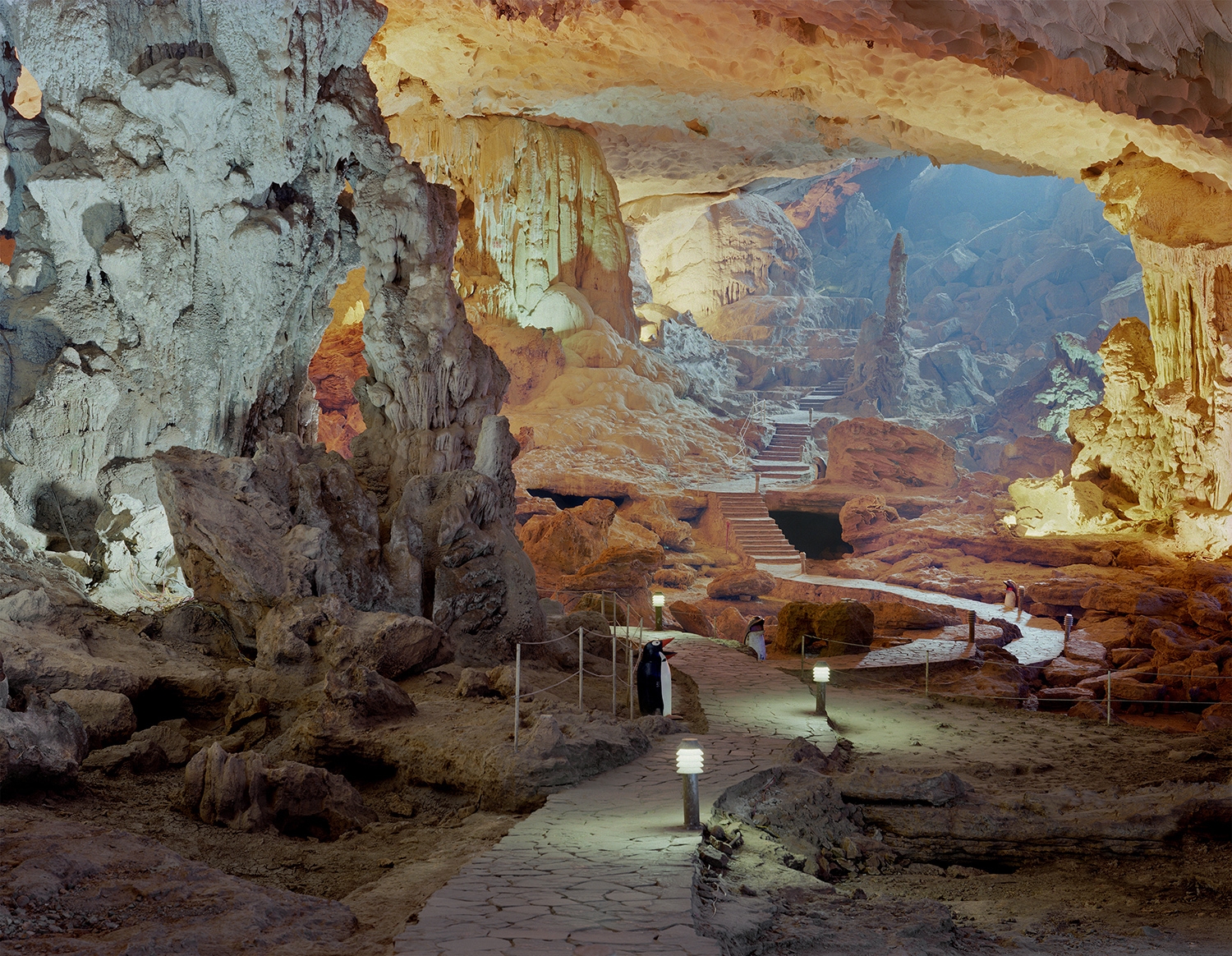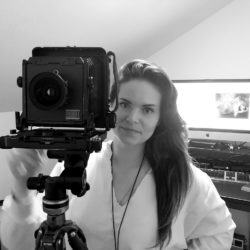



Interview with Austin Irving
BIFA 2020 Winner, 1st Place, Professional Science category, “Show Caves”
Q: Tell us a little bit about your background?
I am a visual artist who works with large format color negative and whose projects investigate the universality of human environments and their impact on our psyches. My interest in the effects that the spaces we inhabit have on our psyches stems directly from my experiences as a child growing up in the garment district of Manhattan and being exposed to Surrealist art at an early age. I developed a heightened sensitivity to the nuances of spaces as a very young person, and I have remained curious about this connection ever since. My freshman year of high school, I discovered the glory of processing and printing in a darkroom and became the school’s lab technician. I was so enamored with this unique environment that I begged my mother to let me paint my room black and switch out all of the regular light bulbs for red ones, just so I could feel like I was in the darkroom all the time – nerd alert! Since receiving my BFA in 2006, I have traveled around the world making and exhibiting large format photographs of spaces that find, follow, comfort, frighten, delight, and haunt me. It is a ritual that helps me make sense of the world and, as I discovered, a way to make visible the hidden aspects of myself that would otherwise remain occluded – visual clues into my inner landscape.
Q: What was your last work and what inspired you to go through with it?
My last big shoot was actually for my SHOW CAVES project. I had the opportunity to photograph Timpanogus Cave in northern Utah and am totally thrilled with the images I made in that cave. Timpanogus is unique to all of my other cave experiences because the cave is only accessible by climbing up the side of a very steep mountain. I got a permit to shoot in the cave for two consecutive days and I am so proud of myself for making it to the top while carrying all of my camera equipment, twice! I enjoyed two exhilarating days of shooting and I am grateful to have been able to spend so much time in such a magical place – the cave was incredibly beautiful.
Q: In your free time or as a hobby, what genre of photography do you enjoy most?
In my free time, I like looking at art of all kinds! I especially like the work of Thomas Demand, Bernd & Hilla Becher, MC Escher, Rene Magritte, Lynne Cohen, George Tooker, and James Turrell.
Q: Your work Show Caves poses an important question regarding natural attractions: is human activity disrupting the delicate environment, or is it trying to raise awareness towards the preservation thereof? What is your personal opinion on this subject?
This is such an interesting question because I really can see both sides. On the one hand, my images wouldn’t even exist if lighting hadn’t been brought into the caves or pathways hadn’t been created to navigate all of the tight spaces with all of my equipment. The time that I spend inside caves making long exposures is incredibly powerful – I can feel the weight of the millions of years it took to create these rocks. These humbling experiences are often quite emotional for me. I find having access to these spaces also gives me the opportunity to contemplate the role that caves have played in our collective unconscious. Humans have spent a lot of time in caves as these spaces were integral to our survival as a species. Very recently, this year in fact, archaeologists announced the discovery of cave art at least 45,500 years old in Leang Tedongnge cave, Indonesia! But access to caves comes at a price. I have visited some caves that are more interested in leaving a smaller footprint than others, and the effects of a high level of interference can be sad to observe. One example of the negative effects of cave tourism is White-nose syndrome, a fugal disease that effect bats which is considered one of the worst wildlife diseases in modern times and has killed millions of bats across North America. Humans can spread the fungus from one hibernaculum to another by accidentally carrying the fungus on shoes or clothing if they aren’t washed between cave visits.
Q: You won the Science Photographer of the Year 2020 title. What does winning this award mean to you?
Winning Science Photographer of the Year means so much to me! It is such an honor, especially in 2020 which, as we all know, was an extremely challenging year. I am thrilled that my SHOW CAVES project has been getting more recognition. I have been working on this series since 2009 and am very passionate about this subject matter. I find the anthropocentric tendencies of modern tourism to be endlessly fascinating, and at times almost sci-fi, and am very pleased that the judges also found this project to be of interest.
Q: Science photography must show you interesting insight into the world around us. What was the most interesting thing you have ever seen during your job?
I have seen so many incredible things while shooting on location, I am very lucky to have had the opportunity to travel to so many cool and interesting places. Aside from all of the astounding rock formations I have seen in caves in India, Vietnam, Singapore, New Mexico, Texas, Iowa, Virginia, Arizona, Missouri, Colorado, Minnesota, New York, Utah, and Tennessee, I especially enjoyed my encounters with the animals that lived in the Batu Cave outside of Kuala Lumpur in Malaysia. There were chickens, long-tailed macaques, and little pigmy cats that all seemed to be living harmoniously in the cave, and almost felt like they were the ones in charge!
Q: What would be your dream project in photography if there would be no budget limits and you could travel anywhere, photograph anything/anyone?
Honestly, I would continue to shoot more caves. There are still dozens of other caves that I would like to photograph for this project including Erdmanns Cave in Germany, Coves dels Hams in Spain, Cave of the Lakes in Greece, Ledenika in Bulgaria, and Jeita Grotto in Lebanon, Caves of Aggtelek Karst, Hungary/Slovakia, Ajanta Caves in Maharashtra, India, Akiyoshidai Cave in Yamaguchi, Japan, Alisadr Cave, in Hamedan, Iran (largest water cave), and a lot more other caves, almost in every corner of the globe.
Q: What would be the one advice you would give to photographers just starting out?
My advice would be to follow your intuition and start to identify and photograph the things that truly excite you. Make images of things that you like, not what you think other people might want to see. There is nothing more valuable than trusting your impulses. Follow them wholeheartedly – wherever that path may lead you. I have found that a large part of what it means to be an artist is engaging in an extended trust fall with myself. Trust that your point of view is valuable and unique and don’t let anyone convince you otherwise.
Q: Are you working on something new right now? Can you tell us a little bit about it?
I am currently working on developing a new series of large format analog photographs that explores liminal spaces that exist in the virtual world of Minecraft, a video game in which players create and break apart various kinds of blocks in three-dimensional worlds. The new project is a collaboration between me and my partner, Lance Holte, who has been building a unique world in Minecraft for the past nine years. This project is in conversation with another project that I have been working on for many years called NOT AN EXIT. This series is a collection of large format photographs that proposes a closer examination of the nondescript interiors that we routinely pass through; doorways and hallways, spaces intended for movement but here, somehow appear impenetrable.